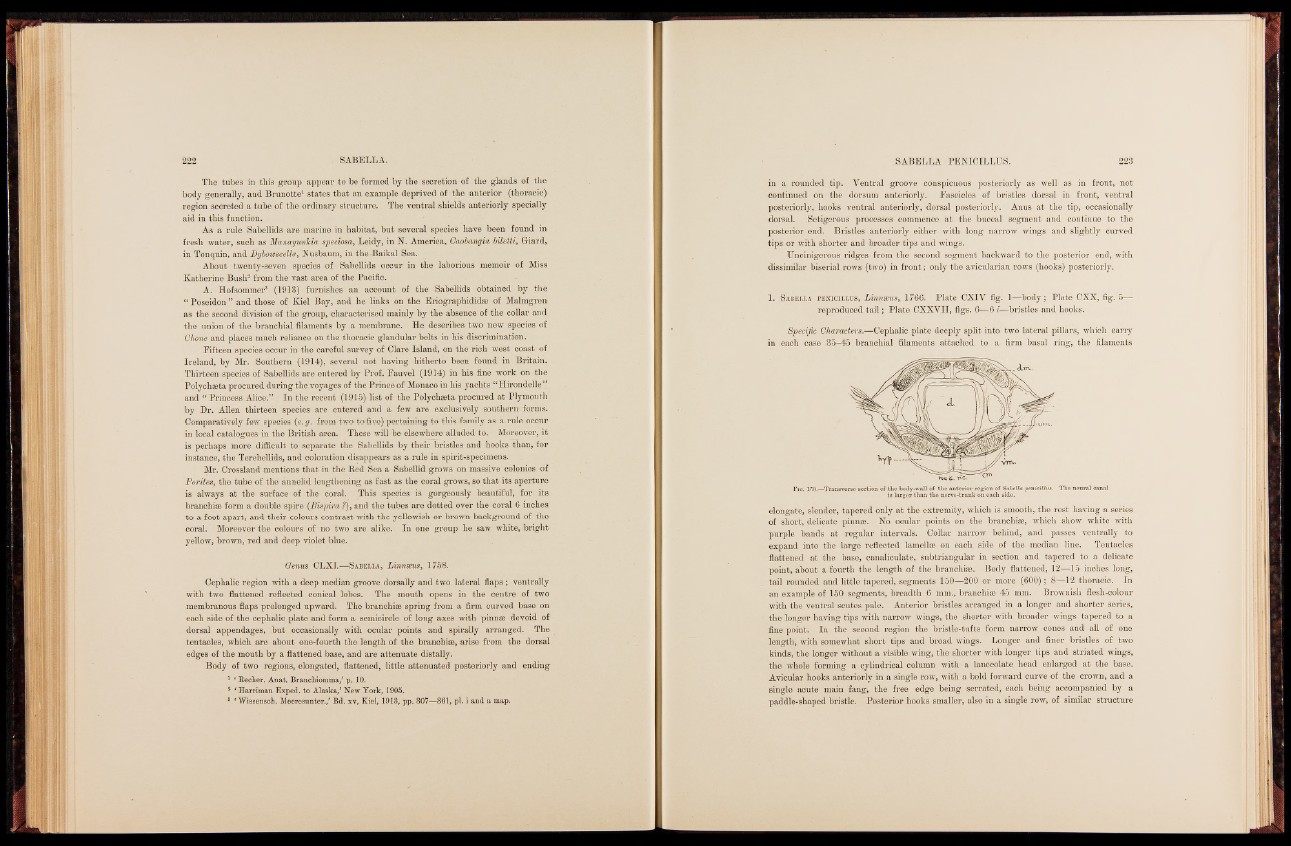
The tubes in this group appear to be formed by the secretion of the glands of the
body generally, and Brunotte1 states that an example deprived of the anterior (thoracic)
region secreted a tube of the ordinary structure. The ventral shields anteriorly specially
aid in this function.
As a rule Sabellids are marine in habitat, but several species have been found in
fresh water, such as Manayunlcia speciosa, Leidy, in N. America, Oaobangia biletti, Giard,
in Tonquin, and Dybowscella, Nusbaum, in the'Baikal Sea.
About twenty-seven species of Sabellids occur in the laborious memoir of Miss
Katherine Bush2 from the vast area of the Pacific.
A. Hofsommer8 (1913) furnishes an account of the Sabellids obtained by the
“ Poseidon ” and those of Kiel Bay, and he links on the Eriographididae of Malmgren
as the second division of the group, characterised mainly by the absence of the collar and
the union of the branchial filaments by a membrane. He describes two new species of
Chone and places much reliance on the thoracic glandular belts in his discrimination.
Fifteen species occur in the careful survey of Clare Island, on the rich west coast of
Ireland, by Mr. Southern (1914), several not having hitherto been found in Britain.
Thirteen species of Sabellids are entered by Prof. Fauvel (1914) in his fine work on the
Polychmta procured during the voyages of the Prince of Monaco in his yachts “Hirondelle”
and “ Princess Alice.” In the recent (1915) list of the Polychgeta procured at Plymouth
by Dr. Allen thirteen species are entered and a few are exclusively southern- forms.
Comparatively few species (e. g. from two to five) pertaining to this family as a rule occur
in local catalogues in the British area. These will be elsewhere alluded to. Moreover, it
is perhaps more difficult to separate the Sabellids by their bristles and hooks than, for
instance, the Terebellids, and coloration disappears as a rule in spirit-specimens.
Mr. Crossland mentions that in the Red Sea a Sabellid grows on massive colonies of
Porites, the tube of the annelid lengthening as fast as the coral grows, so that its aperture
is always at the surface of the coral. This species is gorgeously beautiful, for its
branchiae form a double spire (Bispira ?), and the tubes are dotted over the coral 6 inches
to a foot apart, and their colours contrast with the yellowish or brown background of the
coral. Moreover the colours of no two are alike. In one group he saw white, bright
yellow, brown, red and deep violet blue.
Genus CLXI.—S abella, Linnaeus, 1758.
Cephalic region with a deep median groove dorsally and two lateral flaps ; ventrally
with two flattened reflected conical lobes. The mouth opens in the centre of two
membranous flaps prolonged upward. The branchiae spring from a firm curved base on
each side of the cephalic plate and form a semicircle of long axes with pinnae devoid of
dorsal appendages, but occasionally with ocular points and spirally arranged. The
tentacles, which are about one-fourth the length of the branchiae, arise from the dorsal
edges of the mouth by a flattened base, and are attenuate distally.
Body of two regions, elongated, flattened, little attenuated posteriorly and ending
1 ‘ Recher. Anat. Branchiomma/ p. 10.
2 ‘ Harriman Exped. to Alaska,’ New York, 1905.
8 * Wissensch. Meeresunter./ Bd. xv, Kiel, 1913, pp. 307—361, pi. i and a map.
in a rounded tip. Ventral groove conspicuous posteriorly as well as in front, not
continued on the dorsum anteriorly. Fascicles of bristles dorsal in front, ventral
posteriorly, hooks ventral anteriorly, dorsal posteriorly. Anus at the tip, occasionally
dorsal. Setigerous processes commence at the buccal segment and continue to the
posterior end. Bristles anteriorly either with long narrow wings and slightly curved
tips or with shorter and broader tips and wings.
Uncinigerous ridges from the second segment backward to the posterior end, with
dissimilar biserial rows (two) in front; only the avicularian rows (hooks) posteriorly.
1. S abella pen ic illu s, Linnaeus, 1766. Plate CXIV fig. 1—body; Plate CXX, fig. 5—
reproduced tail; Plate CXXVII, figs. 6—6 i—bristles and hooks.
Specific Characters.—Cephalic plate deeply split into two lateral pillars, which carry
in each case 35-45 branchial filaments attached to a firm basal ring, the filaments
Fig. ISO.—Transverse section of the body-wall of the anterior is larger than the nerve-trunkr eogni oenac ohf sSiadbe.ella penicillus. The neural canal
elongate, slender, tapered only at the extremity, which is smooth, the rest having a series
of short, delicate pinnae. No ocular points on the branchiae, which show white with
purple bands at regular intervals. Collar narrow behind, and passes ventrally to
expand into the large reflected lamellae on each side of the median line. Tentacles
flattened at the base, canaliculate, subtriangular in section and tapered to a delicate
point, about a fourth the length of the branchiae. Body flattened, 12—15 inches long,
tail rounded and little tapered, segments 150—200 or more (600) ; 8 S l2 thoracic. In
an example of 150 segments, breadth 6 inm., branchiae 45 mm. Brownish flesh-colour
with the ventral scutes pale. Anterior bristles arranged in a longer and shorter series,
the longer having tips with narrow wings, the shorter with broader wings tapered to a
fine point. In the second region the bristle-tufts form narrow cones and all of one
length, with somewhat short tips and broad wings. Longer and finer bristles of two
kinds, the longer without a visible wing, the shorter with longer tips and striated wings,
the whole forming a cylindrical column with a lanceolate head enlarged at the base.
Avicular hooks anteriorly in a single row, with a bold forward curve of the crown, and a
single acute main fang, the free edge being serrated, each being accompanied by a
paddle-shaped bristle. Posterior hooks smaller, also in a single row, of similar structure